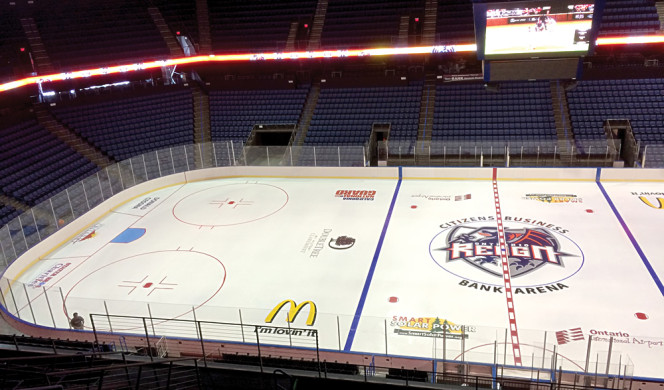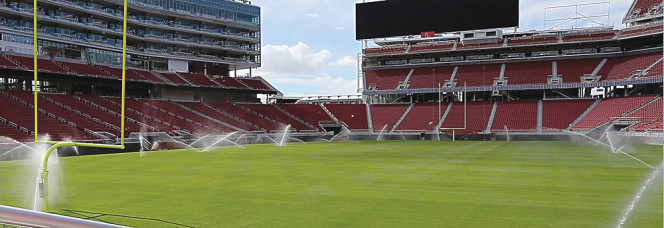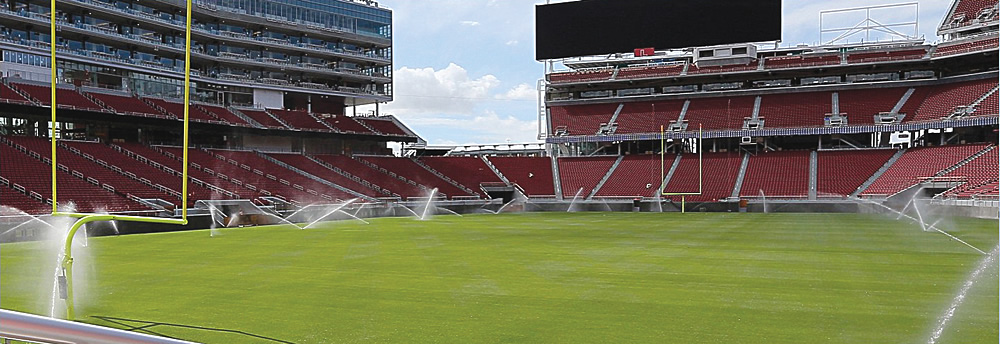The San Francisco 49ers’ new stadium, and an ice hockey arena in Los Angeles, both tap municipal systems to utilize recycled water.
Marsha Johnston
BioCycle March/April 2015

The 225,000 sq. ft. Citizens Business Bank Arena in Los Angeles, home of the Ontario Reign, uses reclaimed water to make the ice for its hockey rink. Dechlorination is needed to make the ice clear.
Photo courtesy of Citizens Business Bank Arena
Citizens Business Bank Arena, home of Ontario Reign, the Los Angeles Kings’ ice hockey farm team, and Levi’s Stadium, home to the San Francisco 49ers, may be the country’s first professional sports venues to massively employ reclaimed sewage water in their operations. “As far as we know, these guys are the only ones,” says David Muller of the Green Sports Alliance (GSA), which hosted a webinar in January to highlight the achievements. “In any case, they are few and far between.”
Muller notes that incorporating reclaimed water into a venue requires either building a catchment and filtration and piping system or having a municipal system to tap into. “Both Levi’s Stadium and Citizens Business Bank Arena were able to tap municipal systems, which we expect to grow a lot, especially in California, with the pressure on water resources,” he says. Indeed, in the arid eastern region of Los Angeles known as the Inland Empire, rainfall is scarce, and its five major water facilities reclaim 50 million gallons/day of wastewater. From the day it opened in October 2008, the 225,000-square-foot Citizens Business Bank Arena used reclaimed sewage water for irrigation of its outdoor landscaping. “We had the luxury that in this building all irrigation was provided by reclaimed water, which costs 50 percent less than fresh water,” says Rich Vartigian, director of operations for Citizens Business Bank Arena.
When he and facilities engineer supervisor Kelly White began looking for more operational cost savings, they knew that most of their fresh water use went to cool the arena and to create the ice slab. A reclaimed water line runs about 25 to 30 feet from its two 700-ton Carrier chiller towers. In 2013, the arena began using reclaimed water for air conditioning, and last October, it was used to make the hockey ice. For the chillers, MacMillan Water Treatment, an in-house firm to arena operator AEG, had to adjust some of the water treatment practices to remove more of the excess chlorine found in reclaimed water. The rink ice, which stays in place for the season, requires between 14,000 to 15,000 gallons of water to make.
“The $15,000 for the ice slab was higher because we had to add extra filtration to get total dissolved solids (TDS) down to a respectable amount before making the ice,” explains Vartigian. “You have to have TDS as low as possible to have clear ice. Fresh water had 300 ppm [parts per million], and the reclaimed water was 650 ppm, but the chlorine was the highest percentage of that ppm. MacMillan provided a real-time analyzer to dechlorinate the reclaimed water with sodium bisulfate prior to entering the reverse osmosis system. Now we are getting between 15 and 20 ppm.” Even though some people were concerned that maybe some bacteria lurked in the reclaimed water, Citizens runs it through tankless water heaters to 160°F, so there has been no issue.

The $1.3 billion LEED Gold Levi Stadium in Santa Clara, home of the San Francisco 49ers, uses reclaimed water to irrigate the playing field and a green roof on one of the suite towers, as well as for all toilet and urinal flushing.
Photo courtesy of Levi Stadium
Levi Stadium
The brand new $1.3-billion LEED Gold Levi’s Stadium in Santa Clara benefitted from a 34-mile reclaimed water network already in place, where reclaimed water accounts for 13 percent of total city water sales. Situated approximately a mile from San Francisco Bay and 20 feet from a federally protected salmon creek, protecting wildlife and regional natural resources was a prime motivation for the stadium, explains Pat Rogan, director of engineering operations for the 49ers Stadium Management Co. Levi Stadium uses reclaimed water for irrigating the playing field, a green roof on its luxury suite tower and landscaping (with drought-resistant plants), and for cooling towers and all toilet and urinal flushing. Based on monthly usage since it opened last summer, Rogan says the stadium is “getting pretty close” to 84 percent total reclaimed water use per year, or 131.8 acre-feet out of a total of 157.4 acre-feet.
Building the double-plumbed facility with bright purple pipes for reclaimed water was not trivial, he adds. “When we were building the stadium, a dual-pump facility of its size had not been built in California, and we had to train the state officials.” Other challenges included having to keep the reclaimed water away from concessions and restaurants, compliance reporting and monitoring, and ensuring high water quality for the playing field. They also had to change the purple of the reclaimed water pipes on signs to the 49er’s red and gold to avoid having opponent colors posted throughout the stadium.
Citizens Business Bank Arena, too, had some minor challenges on both the chiller and rink ice projects, which together cost between $27,000 and $28,000. Overall, the shift to reclaimed water was worth it, concludes Vartigian. Switching from fresh to reclaimed water averages out to $10,000 and 5 million gallons of fresh water per year in savings. “People have not even noticed that we use reclaimed water,” he says, “and we’ve had only positive response!”
Marsha W. Johnston is Principal of Earth Steward Associates in Arlington, VA and a Contributing Writer to BioCycle.













